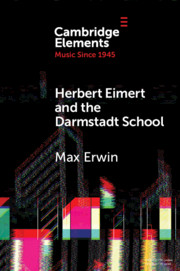Refine search
Actions for selected content:
8 results
Chapter 33 - At Home in Baden-Baden
- from Part VI - At Home and Abroad
-
-
- Book:
- Boulez in Context
- Published online:
- 08 July 2025
- Print publication:
- 24 July 2025, pp 339-348
-
- Chapter
- Export citation
Chapter 16 - Festival Time at Donaueschingen, Darmstadt and Le Domaine Musical
- from Part III - Engagements with the Post-War Generation of Composers
-
-
- Book:
- Boulez in Context
- Published online:
- 08 July 2025
- Print publication:
- 24 July 2025, pp 164-173
-
- Chapter
- Export citation
Chapter 9 - Boulez and the Second Viennese Composers
- from Part II - Musical Modernism
-
-
- Book:
- Boulez in Context
- Published online:
- 08 July 2025
- Print publication:
- 24 July 2025, pp 84-92
-
- Chapter
- Export citation
Chapter 31 - Pierre Boulez at the BBC
- from Part V - Multiple Activities
-
-
- Book:
- Boulez in Context
- Published online:
- 08 July 2025
- Print publication:
- 24 July 2025, pp 320-326
-
- Chapter
- Export citation
Chapter 17 - The Compositional Context
- from Part III - Britten and Other Composers
-
-
- Book:
- Benjamin Britten in Context
- Published online:
- 31 March 2022
- Print publication:
- 21 April 2022, pp 147-154
-
- Chapter
- Export citation
Chapter 28 - Mahler and the Second Viennese School
- from Part V - Influence
-
-
- Book:
- Mahler in Context
- Published online:
- 18 December 2020
- Print publication:
- 19 November 2020, pp 242-250
-
- Chapter
- Export citation

Herbert Eimert and the Darmstadt School
- The Consolidation of the Avant-Garde
-
- Published online:
- 09 November 2020
- Print publication:
- 03 December 2020
-
- Element
- Export citation
Chapter 5 - Aesthetics, Music, Noise
- from Part I - Origins
-
-
- Book:
- Sound and Literature
- Published online:
- 29 May 2020
- Print publication:
- 18 June 2020, pp 114-132
-
- Chapter
- Export citation
